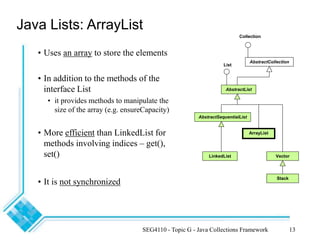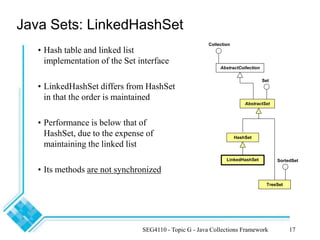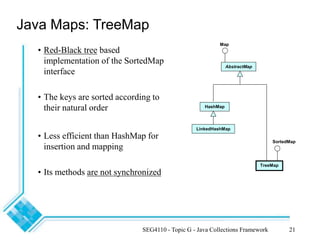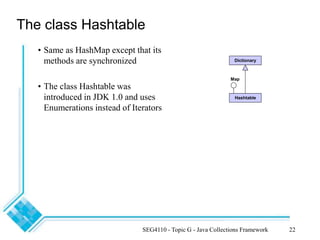The document provides an overview of the Java Collections Framework, detailing its architecture, including collection interfaces, implementation classes, and utility functions. It describes various collection types such as lists, sets, and maps, along with their specific interfaces and characteristics. Additionally, it compares different implementations like ArrayList, LinkedList, HashSet, and HashMap, emphasizing performance and synchronization aspects.
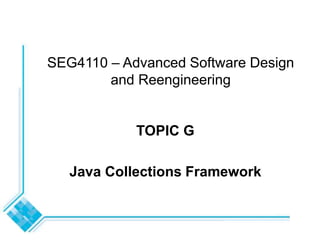
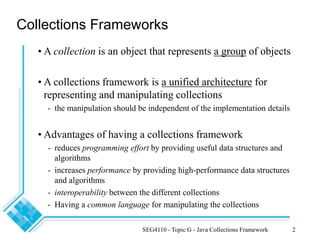


![SEG4110 - Topic G - Java Collections Framework 5
Interface: Collection
• The Collection interface is the root
of the collection hierarchy
• Some Collection implementations
allow
- duplicate elements and others do not
- the elements to be ordered or not
• JDK doesn't provide any direct
implementations of this interface
- It provides implementations of more
specific sub interfaces like Set and List
public interface Collection {
// Basic Operations
int size();
boolean isEmpty();
boolean contains(Object element);
boolean add(Object element);
boolean remove(Object element);
Iterator iterator();
// Bulk Operations
boolean containsAll(Collection c);
boolean addAll(Collection c);
boolean removeAll(Collection c);
boolean retainAll(Collection c);
void clear();
// Array Operations
Object[] toArray();
Object[] toArray(Object a[]);
}](https://image.slidesharecdn.com/topic-g-javacollectionsframework-240424154527-54dd0160/85/Topic-G-JavaCollections-Framework-ppt-5-320.jpg)
![SEG4110 - Topic G - Java Collections Framework 6
Interface: Set
• A Set is a collection that
cannot contain duplicate
elements
• A set is not ordered
- however, some subsets
maintain order using extra data
structures
• This is similar to the
mathematical concept of sets
public interface Set {
// Basic Operations
int size();
boolean isEmpty();
boolean contains(Object element);
boolean add(Object element);
boolean remove(Object element);
Iterator iterator();
// Bulk Operations
boolean containsAll(Collection c);
boolean addAll(Collection c);
boolean removeAll(Collection c);
boolean retainAll(Collection c);
void clear();
// Array Operations
Object[] toArray();
Object[] toArray(Object a[]);
}](https://image.slidesharecdn.com/topic-g-javacollectionsframework-240424154527-54dd0160/85/Topic-G-JavaCollections-Framework-ppt-6-320.jpg)






